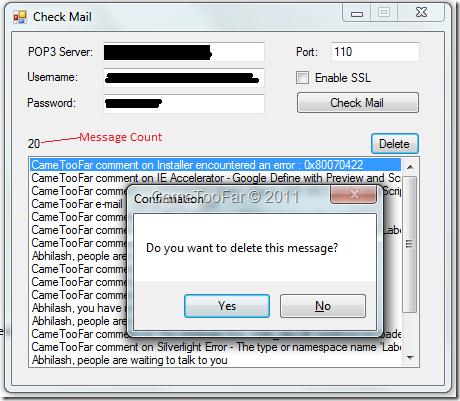Read and Delete mails through POP3 using C#

For storing the mail details (like Subject, message number, etc.), I created a custom class as below:
1: usingSystem;
2: usingSystem.Collections.Generic;
3: usingSystem.Text;
4:
5: namespacePOP3_MailHandling
6: {
7: /// <summary>
8: /// Custom class that holds the Mail details
9: /// </summary>
10: publicclassPop3Mails
11: {
12: /// <summary>
13: /// Message number of the mail.
14: /// This number is used to delete the mails
15: /// </summary>
16: publicintMessageNumber { get; set; }
17:
18: /// <summary>
19: /// Subject of the message
20: /// </summary>
21: publicstringSubject { get; set; }
22: }
23:}
This class is populated with the mail details into a Generic List collection, which is then bound to a ListBox to display the details.
The code for loading messages and deleting the selected mail is as below and is commented well, so that comes to be self-explanatory.
1: usingSystem;
2: usingSystem.Collections.Generic;
3: usingSystem.ComponentModel;
4: usingSystem.Data;
5: usingSystem.Drawing;
6: usingSystem.Text;
7: usingSystem.Windows.Forms;
8:
9: // POP.NET Namespace
10: usingOpenPop.Mime;
11: usingOpenPop.Mime.Header;
12: usingOpenPop.Pop3;
13: usingOpenPop.Pop3.Exceptions;
14: usingOpenPop.Common.Logging;
15:
16: // Used to avaoid ambiguity between
17: // System.Windows.Forms.Message & OpenPop.Mime.Message
18: usingPop3Message = OpenPop.Mime.Message;
19:
20: namespacePOP3_MailHandling
21: {
22: publicpartialclassForm1 : Form
23: {
24: Pop3Client _pop3;
25: Pop3Message _message;
26:
27: Pop3Mails _mails;
28: List<Pop3Mails> _lstMails;
29:
30: /// <summary>
31: /// Gets the total Message Count
32: /// </summary>
33: int_totalMsgCount = 0;
34:
35: publicForm1()
36: {
37: InitializeComponent();
38: }
39:
40: /// <summary>
41: /// Check Mail
42: /// </summary>
43: /// <param name="sender"></param>
44: /// <param name="e"></param>
45: privatevoidbtnCheckMail_Click(objectsender, EventArgs e)
46: {
47: _pop3 = newPop3Client();
48:
49: try
50: {
51: // Connect to mail-server
52: _pop3.Connect(txtPop3Server.Text.Trim(), Convert.ToInt32(txtPort.Text.Trim()), chkSSL.Checked);
53:
54: if(_pop3.Connected)
55: {
56: // Authenticate
57: _pop3.Authenticate(txtUsername.Text.Trim(), txtPassword.Text.Trim());
58:
59: // Get Total Count
60: _totalMsgCount = _pop3.GetMessageCount();
61: lblTotalMsg.Text = _totalMsgCount.ToString();
62:
63: // Check for Mails
64: if(_totalMsgCount == 0)
65: {
66: MessageBox.Show("Mailbox is empty");
67: return;
68: }
69:
70: // Clear Listbox
71: lstboxMails.Items.Clear();
72:
73: _lstMails = newList<Pop3Mails>();
74:
75: // Loop through Mails
76: for(into = _totalMsgCount; i <= _totalMsgCount; i–)
77: {
78: if(i == 0)
79: break;
80:
81: // Allow to handle other messages in the message queue
82: // Thus preventing the application to show 'Not Responding'
83: Application.DoEvents();
84:
85: // Mail
86: _message = _pop3.GetMessage(i);
87:
88: // Get mail details
89: _mails = newPop3Mails();
90: _mails.MessageNumber = i;
91: _mails.Subject = _message.Headers.Subject;
92:
93: _lstMails.Add(_mails);
94: }
95:
96: // Bind Mail details
97: lstboxMails.DisplayMember = "Subject";
98: lstboxMails.ValueMember = "MessageNumber";
99: lstboxMails.DataSource = _lstMails;
100:
101: MessageBox.Show("Mail fetching Completed!");
102: }
103: }
104: catch(Exception exp)
105: {
106: MessageBox.Show("Oops! An error occured: "+ exp.Message);
107: }
108: }
109:
110: /// <summary>
111: /// Delete Mail
112: /// </summary>
113: /// <param name="sender"></param>
114: /// <param name="e"></param>
115: privatevoidbtnDeleteMail_Click(objectsender, EventArgs e)
116: {
117: DialogResult dlgResult = MessageBox.Show("Do you want to delete this message?", "Confirmation", MessageBoxButtons.YesNo);
118:
119: if(dlgResult == System.Windows.Forms.DialogResult.No)
120: {
121: return;
122: }
123:
124: // Get the selected mail item
125: Pop3Mails _mailSel = lstboxMails.SelectedItem asPop3Mails;
126:
127: if(_mailSel != null)
128: {
129: // Set the message count to be deleted
130: _pop3.DeleteMessage(_mailSel.MessageNumber);
131:
132: // Calling disconnected deletes the mail from server
133: _pop3.Disconnect();
134: }
135: else
136: {
137: MessageBox.Show("Please select a mail to delete");
138: }
139: }
140: }
141:}
For more Download the attached file…………….














